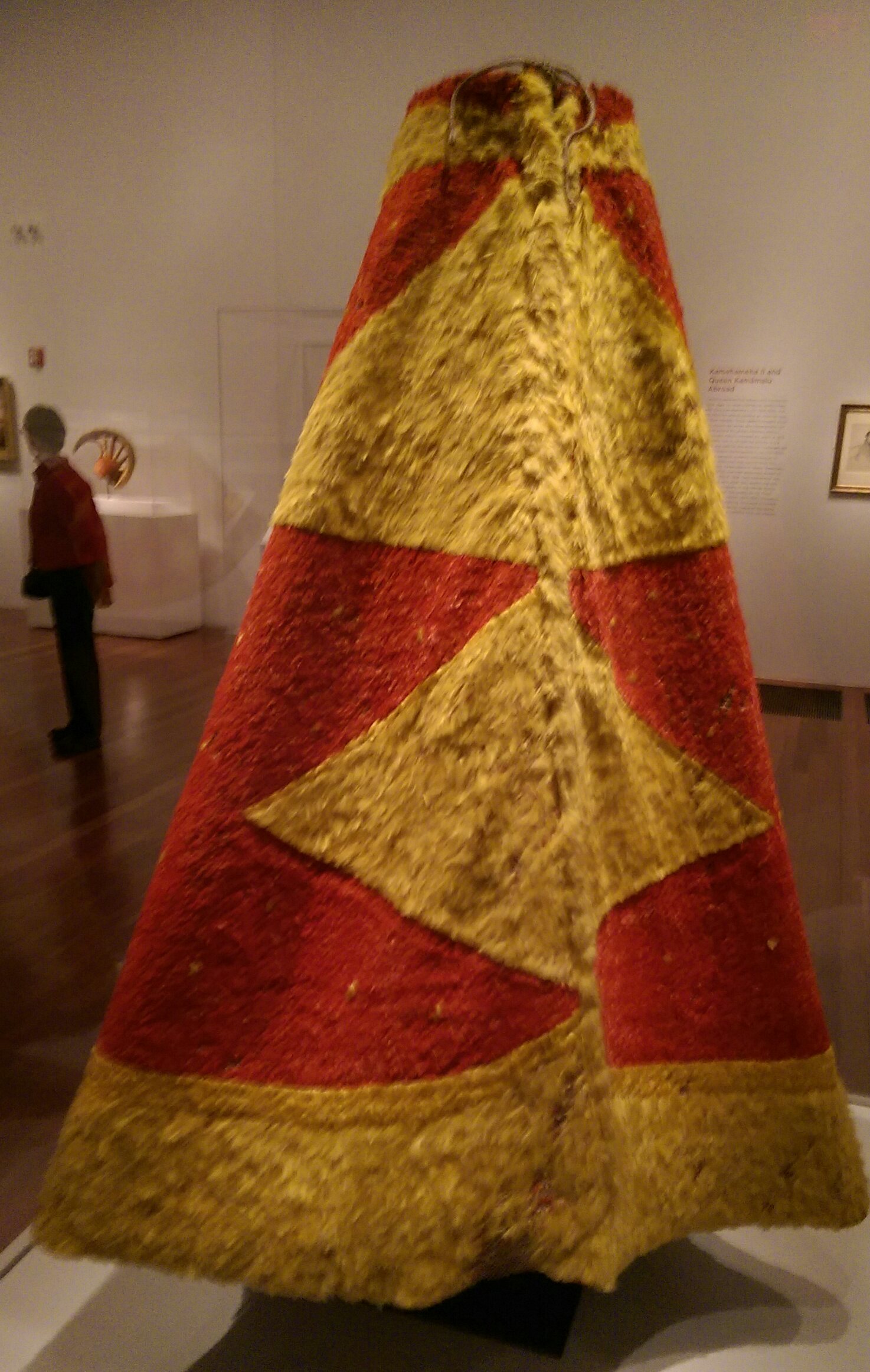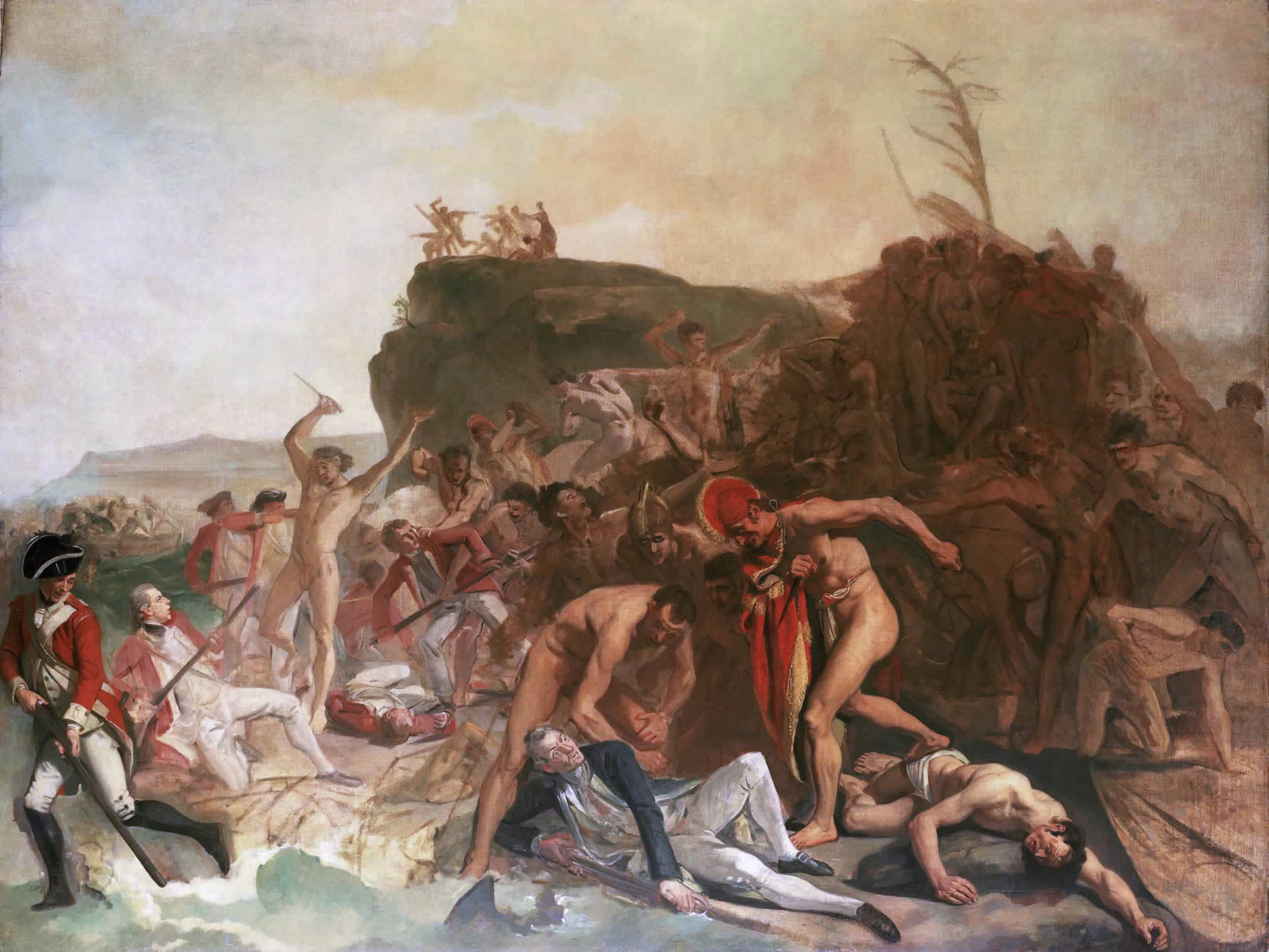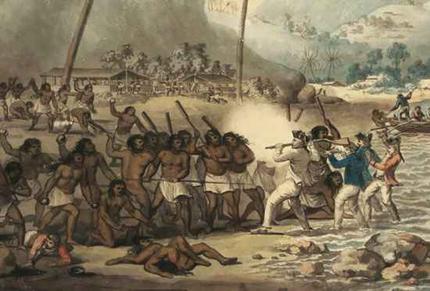|
Kalaniʻōpuʻu
Kalaniōpuu-a-Kaiamamao (c. 1729 – April 1782) was the aliʻi nui (supreme monarch) of the island of Hawaiʻi. He was called ''Terreeoboo, King of Owhyhee'' by James Cook and other Europeans. His name has also been written as Kaleiopuu. Biography Kalaniʻōpuʻu was the son of Kalaninuiamamao (k) and his wife Kamākaʻimoku (w), a high ranking aliʻi wahine (female of hereditary nobility) who was also the mother of Keōua (k) with another husband named Kalanikeʻeaumoku (k). This made her the grandmother of Kamehameha I. During his reign, Alapainui had kept the two young princes, Kalaniʻōpuʻu and Keōua, close to him out of either kindness or politics. Kalaniōpuu-a-Kaiamamao was the king of the island during the times Captain James Cook came to Hawaiʻi and went aboard his ship on November 26, 1778. After Cook anchored at Kealakekua Bay in January 1779, Kalaniōpuu-a-Kaiamamao paid a ceremonial visit on January 26, 1779 and exchanged gifts including a ʻahuʻula (fea ... [...More Info...] [...Related Items...] OR: [Wikipedia] [Google] [Baidu] |
Kānekapōlei
Kānekapōlei was a Native Hawaiian '' aliʻi wahine'' (queen) and wife of Kalaniʻōpuʻu, ''aliʻi nui'' (king/supreme ruler) of the Island of Hawaii and aunt of Kamehameha I, who were all present at Captain James Cook's death. She called attention to the kidnapping of her husband by Cook and his men, attracting his royal attendants to the beach, answering her calls for help. Birth and ancestry Kānekapōlei's father was Kauakahiakua and her mother, ʻUmiaemoku. Kauakahiakua was from the Maui royal family, a grandson of ''mōʻī'' (king), Lonohonuakini through his son Lonomakaihonua and brother of Kaʻulahea II, and Kahāpoʻohiwi. Kauakahiakua had several wives including his full blood sister Kāneikapōleikauila (w). Sibling relationships were sacred and produced the highest ranking ''niaupiʻo'' births. Kauakahiakua and Kāneikapōleikauila had a piʻo son named Kapuaahiwalani (k). Her mother, ʻUmiaemoku, was one of three sisters that included Ikuaana and Umiulaikaahumanu, K ... [...More Info...] [...Related Items...] OR: [Wikipedia] [Google] [Baidu] |
Kamehameha I
Kamehameha I (; Kalani Paiea Wohi o Kaleikini Kealiikui Kamehameha o Iolani i Kaiwikapu kaui Ka Liholiho Kūnuiākea; – May 8 or 14, 1819), also known as Kamehameha the Great, was the conqueror and first ruler of the Kingdom of Hawaii. The state of Hawaii gave a statue of him to the National Statuary Hall Collection in Washington, D.C. as one of two statues it is entitled to install there. Birth and childhood Paternity and family history Kamehameha (known as Paiea at birth), was born to Kekuʻiapoiwa II, the niece of Alapainui, the usurping ruler of Hawaii Island who had killed the two legitimate heirs of Keaweʻīkekahialiʻiokamoku during civil war. By most accounts he was born in Ainakea, Kohala, Hawaii. His father was Keōua Kalanikupuapa'ikalaninui; however, Native Hawaiian historian Samuel Kamakau says that Maui monarch Kahekili II had ''hānai'' adopted (traditional, informal adoption) Kamehameha at birth, as was the custom of the time. Kamakau believes this i ... [...More Info...] [...Related Items...] OR: [Wikipedia] [Google] [Baidu] |
Death Of James Cook
On 14 February 1779, English explorer Captain James Cook attempted to kidnap Kalaniʻōpuʻu, the ruling chief (aliʻi nui) of the island of Hawaii. The decision to hold him in exchange for a stolen longboat was the fatal error of Cook's final voyage, and led to his death at Kealakekua Bay. Cook's arrival in Hawaii was eventually followed by mass migrations of Europeans and Americans to the islands that gave rise to the overthrow of the Kingdom of Hawaii, the aboriginal monarchy of the islands, by pro-American elements beginning in 1893. Arrival James Cook led three separate voyages to chart areas of the globe unknown to the Kingdom of Great Britain. It was on his third and final voyage that he encountered what are known today as the Islands of Hawaii. He first sighted the islands on 18 January 1778. He anchored off the west coast of the island of Kauai near Waimea and met inhabitants to trade and obtain water and food. On 2 February 1778, Cook continued on to the coast ... [...More Info...] [...Related Items...] OR: [Wikipedia] [Google] [Baidu] |
ʻahu ʻula
The ''ʻAhu ʻula'' (feather cloak in the Hawaiian language), and the ''mahiole'' (feather helmet) were symbols of the highest rank of the chiefly ''aliʻi'' class of ancient Hawaii. The feathered cloaks and capes provided physical protection, and were believed to provide spiritual protection for their wearers. There are over 160 examples of this traditional clothing in museums around the world. At least six of these cloaks were collected during the voyages of Captain Cook. These cloaks are made from a woven netting decorated with bird feathers and are examples of fine featherwork techniques. One of these cloaks was included in a painting of Cook's death by Johann Zoffany. Construction The cloaks were constructed using a woven netting decorated with feathers obtained from local birds. The plant used to make the netting is ''Touchardia latifolia'', a member of the nettle family. The coloring was achieved using different types of feathers. Black and yellow came from four specie ... [...More Info...] [...Related Items...] OR: [Wikipedia] [Google] [Baidu] |
ʻAhu ʻula
The ''ʻAhu ʻula'' (feather cloak in the Hawaiian language), and the ''mahiole'' (feather helmet) were symbols of the highest rank of the chiefly ''aliʻi'' class of ancient Hawaii. The feathered cloaks and capes provided physical protection, and were believed to provide spiritual protection for their wearers. There are over 160 examples of this traditional clothing in museums around the world. At least six of these cloaks were collected during the voyages of Captain Cook. These cloaks are made from a woven netting decorated with bird feathers and are examples of fine featherwork techniques. One of these cloaks was included in a painting of Cook's death by Johann Zoffany. Construction The cloaks were constructed using a woven netting decorated with feathers obtained from local birds. The plant used to make the netting is ''Touchardia latifolia'', a member of the nettle family. The coloring was achieved using different types of feathers. Black and yellow came from four specie ... [...More Info...] [...Related Items...] OR: [Wikipedia] [Google] [Baidu] |
Kalaninuiamamao
Kalaninuiamamao (sometimes called Ka-I-i-Mamao or Kaeamamao) was a prince of the Big Island of Hawaii, or 1st Alii Nui of Kaū, an ancestor of the Queen Liliuokalani. Retrieved 2014-5-2. He is probably the Hawaiian chief with the most varied spelling of his name. The was composed in honor of his birth and was passed by him to his daughter Alapaiwahine. Biography Kalaninuiamamao was born of |
Kealakekua Bay
Kealakekua Bay is located on the Kona coast of the island of Hawaii about south of Kailua-Kona. Settled over a thousand years ago, the surrounding area contains many archeological and historical sites such as religious temples (heiaus) and also includes the spot where the first documented European to reach the Hawaiian islands, Captain James Cook, was killed. It was listed in the National Register of Historic Places listings on the island of Hawaii in 1973 as the Kealakekua Bay Historical District. The bay is a marine life conservation district, a popular destination for kayaking, scuba diving, and snorkeling. History Ancient history Settlement on Kealakekua Bay has a long history. ''Hikiau Heiau'' is a luakini temple of Ancient Hawaii located at the south end of the bay, at coordinates . Cook recorded the large platform being about high, long, and wide.Van James, ''Ancient Sites of Hawaii'', 1995, Mutual Publishing, Page 94 The sheer cliff face called Ka-pali-poko—a-Manu ... [...More Info...] [...Related Items...] OR: [Wikipedia] [Google] [Baidu] |
James Cook
James Cook (7 November 1728 Old Style date: 27 October – 14 February 1779) was a British explorer, navigator, cartographer, and captain in the British Royal Navy, famous for his three voyages between 1768 and 1779 in the Pacific Ocean and to New Zealand and Australia in particular. He made detailed maps of Newfoundland prior to making three voyages to the Pacific, during which he achieved the first recorded European contact with the eastern coastline of Australia and the Hawaiian Islands, and the first recorded circumnavigation of New Zealand. Cook joined the British merchant navy as a teenager and joined the Royal Navy in 1755. He saw action in the Seven Years' War and subsequently surveyed and mapped much of the entrance to the St. Lawrence River during the siege of Quebec, which brought him to the attention of the Admiralty and the Royal Society. This acclaim came at a crucial moment for the direction of British overseas exploration, and it led to his commission in ... [...More Info...] [...Related Items...] OR: [Wikipedia] [Google] [Baidu] |
Mahiole
Hawaiian feather helmets, known as ''mahiole'' in the Hawaiian language, were worn with feather cloaks (ʻahu ʻula). These were symbols of the highest rank reserved for the men of the ''alii'', the chiefly class of Hawaii. There are examples of this traditional headgear in museums around the world. At least sixteen of these helmets were collected during the voyages of Captain Cook.To attempt some new discoveries in that vast unknown tract , Smithsonian Museum of Natural History, Washington DC Cook’s Pacific Encounters symposium, National Museum of Australia, 28 July 2006 These helmets are made from a woven frame structure ... [...More Info...] [...Related Items...] OR: [Wikipedia] [Google] [Baidu] |
Kalola Pupuka
Kalola Pupuka-o-Honokawailani was a Hawaiian high chiefess. The first Europeans in Hawaii called her ''Rora-rora.'' Biography She was a daughter of King Kekaulike of Maui and Kekuiapoiwa I. She was the full-blood sister of Kamehamehanui Aiʻluau and Kahekili II. She married the king Kalaniʻōpuʻu of Hawaii and had a son called Kīwalaʻō who became a king. She also married her brother-in-law, chief Keōua, and had a daughter Kekuiapoiwa Liliha. Kekuiapoiwa Liliha married Kīwalaʻō and their child was Queen Keōpūolani, consort of Kamehameha I and mother of two kings. She was also married to her brother Kamehamehanui Aiʻluau at one time with whom she was the mother of Kalanikauikikilokalaniakua, the highest ranking chiefess in her days on whom the sun was not permitted to shine and who was allowed to climb about the kapu heiau A ''heiau'' () is a Hawaiian temple. Made in different architectural styles depending upon their purpose and location, they range from simple ... [...More Info...] [...Related Items...] OR: [Wikipedia] [Google] [Baidu] |
Kīwalaʻō
Kīwalaʻō (1760 – July 1782) was the aliʻi nui of the island of Hawaii in 1782 when he was defeated in battle and overthrown by Kamehameha I. Early life Kīwalaʻō was born in 1760 to Aliʻi Nui, Kalaniʻōpuʻu and his queen consort Kalola Pupuka. He was the eldest son of the ruler and was the heir apparent. While he was alive at the time of Captain Cook's arrival, he was not present and there is no foreign account of him. He is said to have been of a weak character while his half brother Keōua Kuahuula was the exact opposite and more comparable to the knights of the Middle Ages In the history of Europe, the Middle Ages or medieval period lasted approximately from the late 5th to the late 15th centuries, similar to the post-classical period of global history. It began with the fall of the Western Roman Empire a .... Citations References * * * * * * * :3 {{DEFAULTSORT:Kiwalao 1760 births 1782 deaths Royalty of Hawaii (island) House of Keawe< ... [...More Info...] [...Related Items...] OR: [Wikipedia] [Google] [Baidu] |
Keōua Kūʻahuʻula
Keōua Kūahuula was an '' Alii'' (member of the royal class) during the time of the unification of the Kingdom of Hawaii. Family His name means "rain cloud of the red cloak". His father was Kalaniʻōpuʻu, the king at the time of the arrival of Captain James Cook. His mother was Kānekapōlei, one of the later wives of Kalaniōpuu, and mother of Pauli Kaʻōleiokū, the grandfather of Bernice Pauahi Bishop and Ruth Keelikolani. This meant his older half-brother Kīwalaʻō was in line to inherit the kingdom. Later life He was not happy, however, to receive no lands after his father died in 1781. He challenged his cousin Kamehameha I, resulting in the Battle of Moku'ohai. He escaped the battle to relatives in the Kaū district to the South in 1782. Although Kamehameha controlled the West side of the island, repeated raids never resulted in a clear victory for either side. In 1790, after escaping another attack, his party was caught in an eruption of Kilauea, and lost ... [...More Info...] [...Related Items...] OR: [Wikipedia] [Google] [Baidu] |







.jpg)